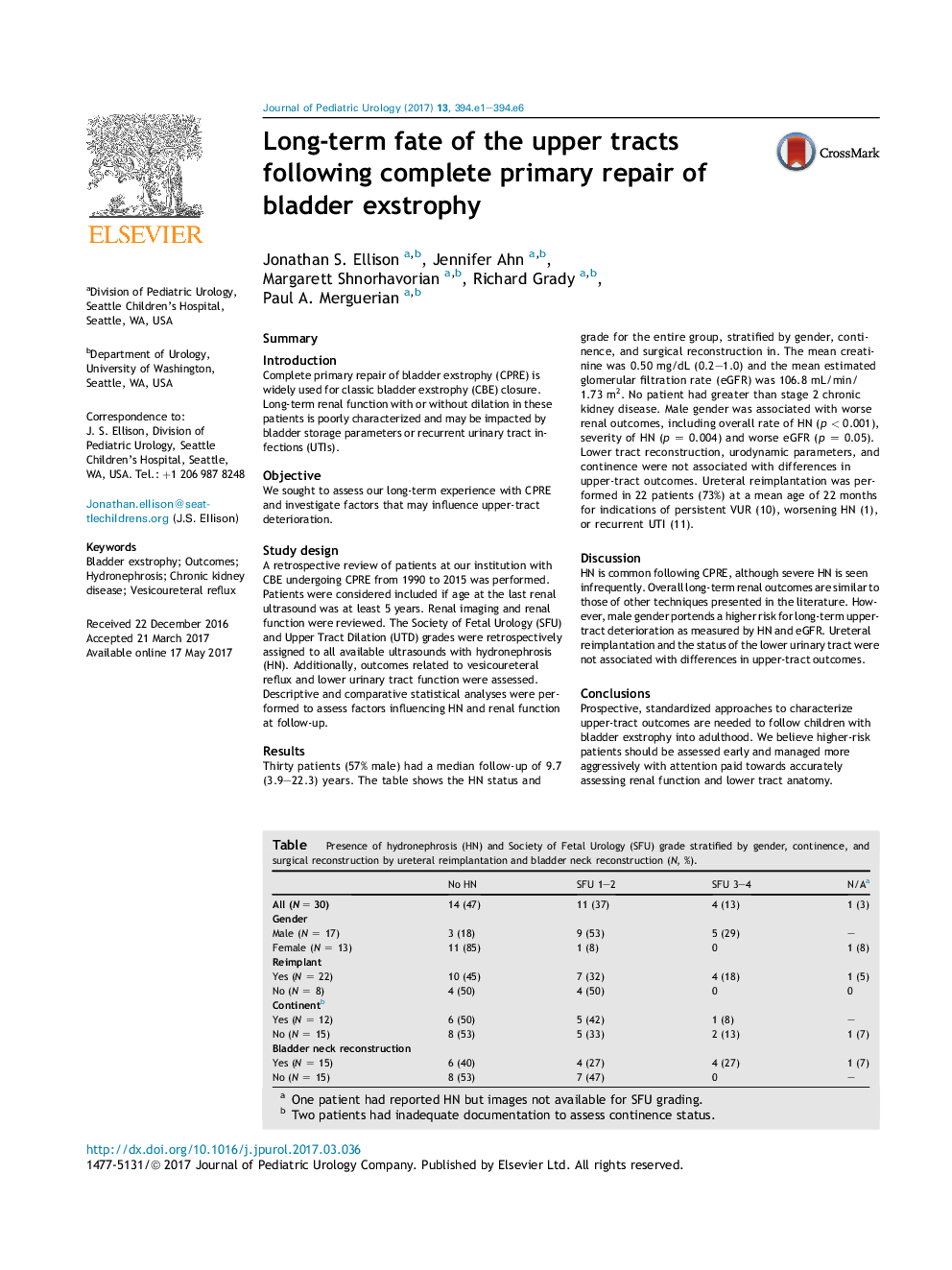| کد مقاله | کد نشریه | سال انتشار | مقاله انگلیسی | نسخه تمام متن |
|---|---|---|---|---|
| 5718562 | 1607135 | 2017 | 6 صفحه PDF | دانلود رایگان |
SummaryIntroductionComplete primary repair of bladder exstrophy (CPRE) is widely used for classic bladder exstrophy (CBE) closure. Long-term renal function with or without dilation in these patients is poorly characterized and may be impacted by bladder storage parameters or recurrent urinary tract infections (UTIs).ObjectiveWe sought to assess our long-term experience with CPRE and investigate factors that may influence upper-tract deterioration.Study designA retrospective review of patients at our institution with CBE undergoing CPRE from 1990 to 2015 was performed. Patients were considered included if age at the last renal ultrasound was at least 5 years. Renal imaging and renal function were reviewed. The Society of Fetal Urology (SFU) and Upper Tract Dilation (UTD) grades were retrospectively assigned to all available ultrasounds with hydronephrosis (HN). Additionally, outcomes related to vesicoureteral reflux and lower urinary tract function were assessed. Descriptive and comparative statistical analyses were performed to assess factors influencing HN and renal function at follow-up.ResultsThirty patients (57% male) had a median follow-up of 9.7 (3.9-22.3) years. The table shows the HN status and grade for the entire group, stratified by gender, continence, and surgical reconstruction in. The mean creatinine was 0.50 mg/dL (0.2-1.0) and the mean estimated glomerular filtration rate (eGFR) was 106.8 mL/min/1.73 m2. No patient had greater than stage 2 chronic kidney disease. Male gender was associated with worse renal outcomes, including overall rate of HN (p < 0.001), severity of HN (p = 0.004) and worse eGFR (p = 0.05). Lower tract reconstruction, urodynamic parameters, and continence were not associated with differences in upper-tract outcomes. Ureteral reimplantation was performed in 22 patients (73%) at a mean age of 22 months for indications of persistent VUR (10), worsening HN (1), or recurrent UTI (11).DiscussionHN is common following CPRE, although severe HN is seen infrequently. Overall long-term renal outcomes are similar to those of other techniques presented in the literature. However, male gender portends a higher risk for long-term upper-tract deterioration as measured by HN and eGFR. Ureteral reimplantation and the status of the lower urinary tract were not associated with differences in upper-tract outcomes.ConclusionsProspective, standardized approaches to characterize upper-tract outcomes are needed to follow children with bladder exstrophy into adulthood. We believe higher-risk patients should be assessed early and managed more aggressively with attention paid towards accurately assessing renal function and lower tract anatomy.Table. Presence of hydronephrosis (HN) and Society of Fetal Urology (SFU) grade stratified by gender, continence, and surgical reconstruction by ureteral reimplantation and bladder neck reconstruction (N, %).No HNSFU 1-2SFU 3-4N/AaAll (N = 30)14 (47)11 (37)4 (13)1 (3)GenderMale (N = 17)3 (18)9 (53)5 (29)-Female (N = 13)11 (85)1 (8)01 (8)ReimplantYes (N = 22)10 (45)7 (32)4 (18)1 (5)No (N = 8)4 (50)4 (50)00ContinentbYes (N = 12)6 (50)5 (42)1 (8)-No (N = 15)8 (53)5 (33)2 (13)1 (7)Bladder neck reconstructionYes (N = 15)6 (40)4 (27)4 (27)1 (7)No (N = 15)8 (53)7 (47)0-aOne patient had reported HN but images not available for SFU grading.bTwo patients had inadequate documentation to assess continence status.
Journal: Journal of Pediatric Urology - Volume 13, Issue 4, August 2017, Pages 394.e1-394.e6
